Study on furfural conversion into aromatics over Zn/HZSM-5 and Fe/HZSM-5 catalysts
ZSM-5 zeolite material (Si/Al ratio = 25) was synthesized with silica source of TEOS and TPAOH template. The
zeolite is modified into proton form (HZSM-5) with 343 m2/g of BET surface area, 324 m2/g of micropore area, 0.1491
cm3/g of micropore volume and 5.77 nm of BJH adsorption average pore width. Zinc oxide and iron oxide are dispersed
onto HZSM-5 catalyst surface with different contents by wet impregnation method. The results of HZSM-5, Zn/HZSM-
5, Fe/HZSM-5 catalyst materials still retain the micropore structure of ZSM-5 zeolite. These materials are used as
catalysts for furfural pyrolysis in the inert atmosphere (N2) with the temperatures ranged from 400 to 700 °C. The
conversion of furfural to aromatic hydrocarbons on catalysts is evaluated by furfural conversion, conversion into
aromatics and aromatic hydrocarbons selectivity. Result shows that 3 %Zn/HZSM-5 and 2 %Fe/HZSM-5 catalyst favor
for furfural pyrolysis at 600 oC. The furfural conversion, the conversion into BTXN and the BTXN selectivity are
respectively 48.36 %, 21.18 %, 16.18 % with 3 %Zn/HZSM-5 catalyst and 64.41 %, 16.47 %, 26.81 % with
2%Fe/HZSM-5 catalyst. These results are the basic research for the upgrade of pyrolysis oil into fuels.
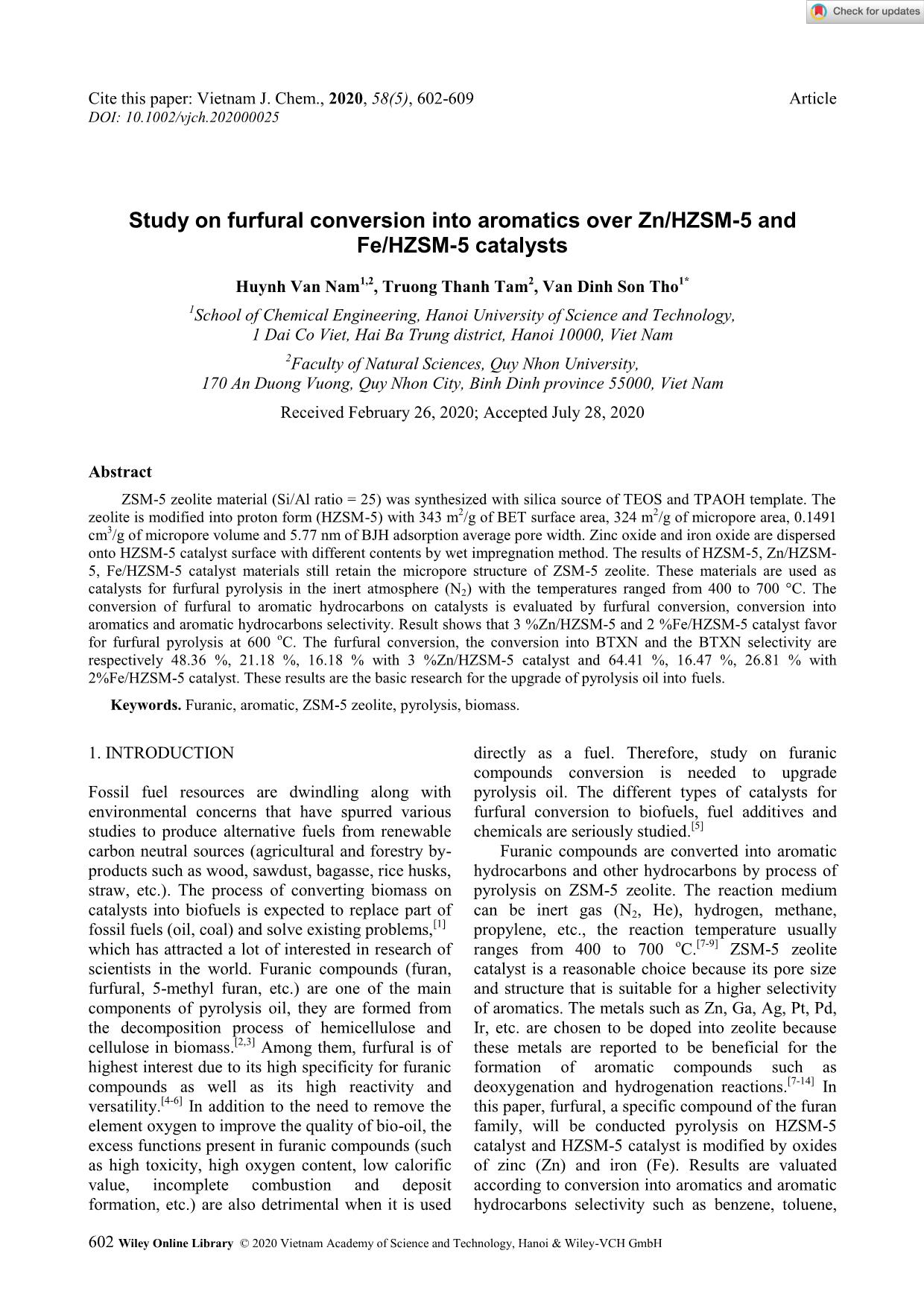
Trang 1
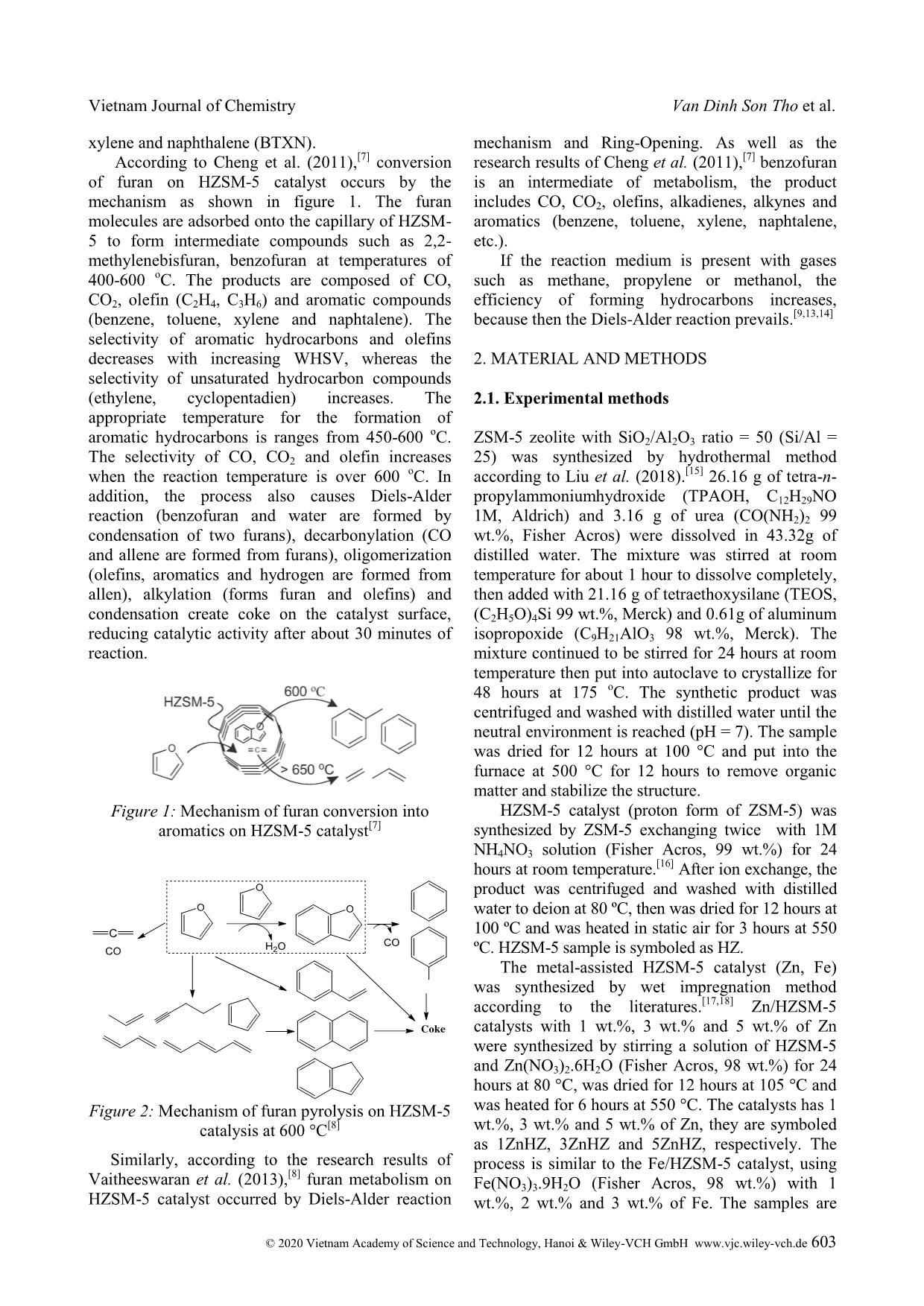
Trang 2
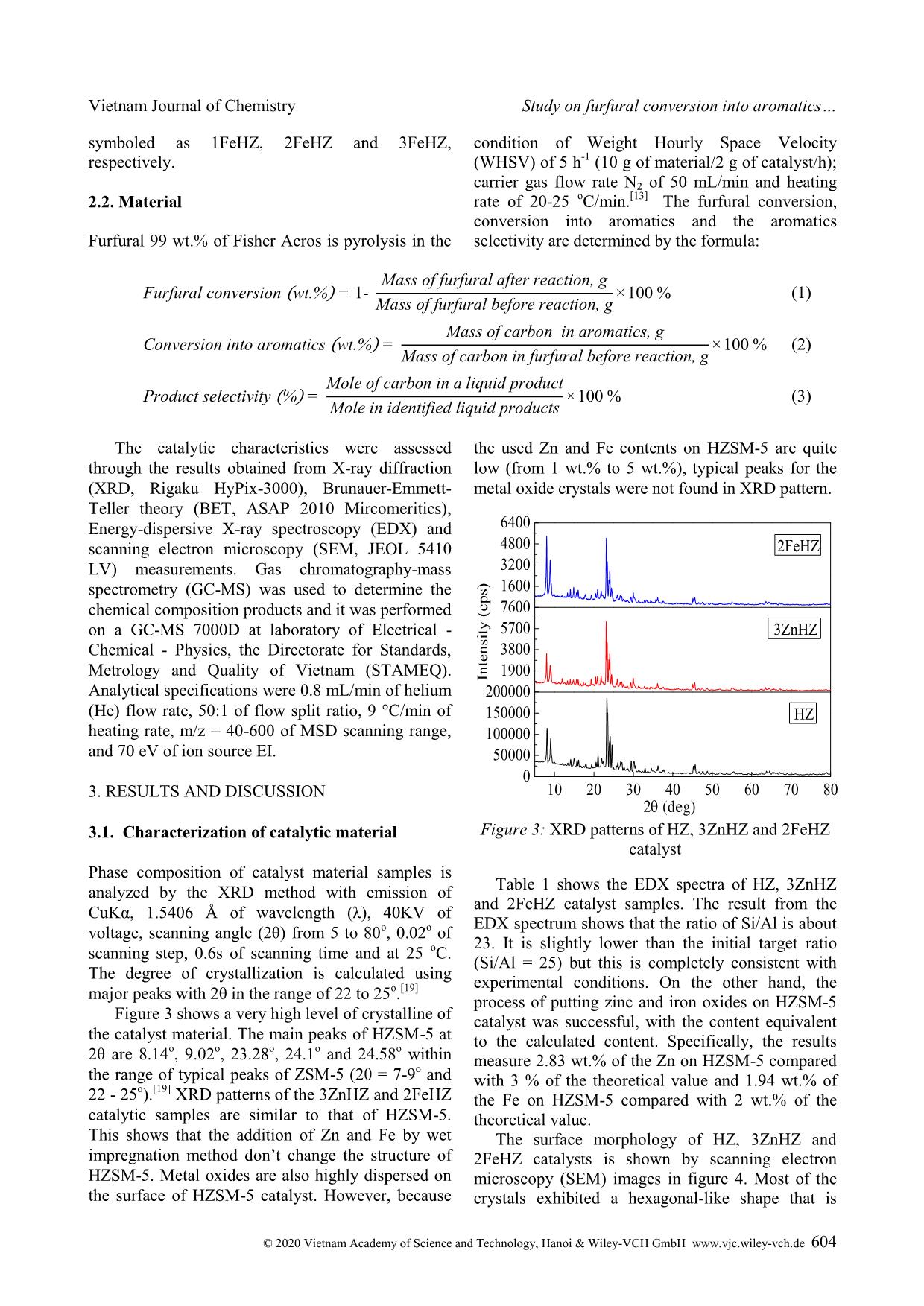
Trang 3
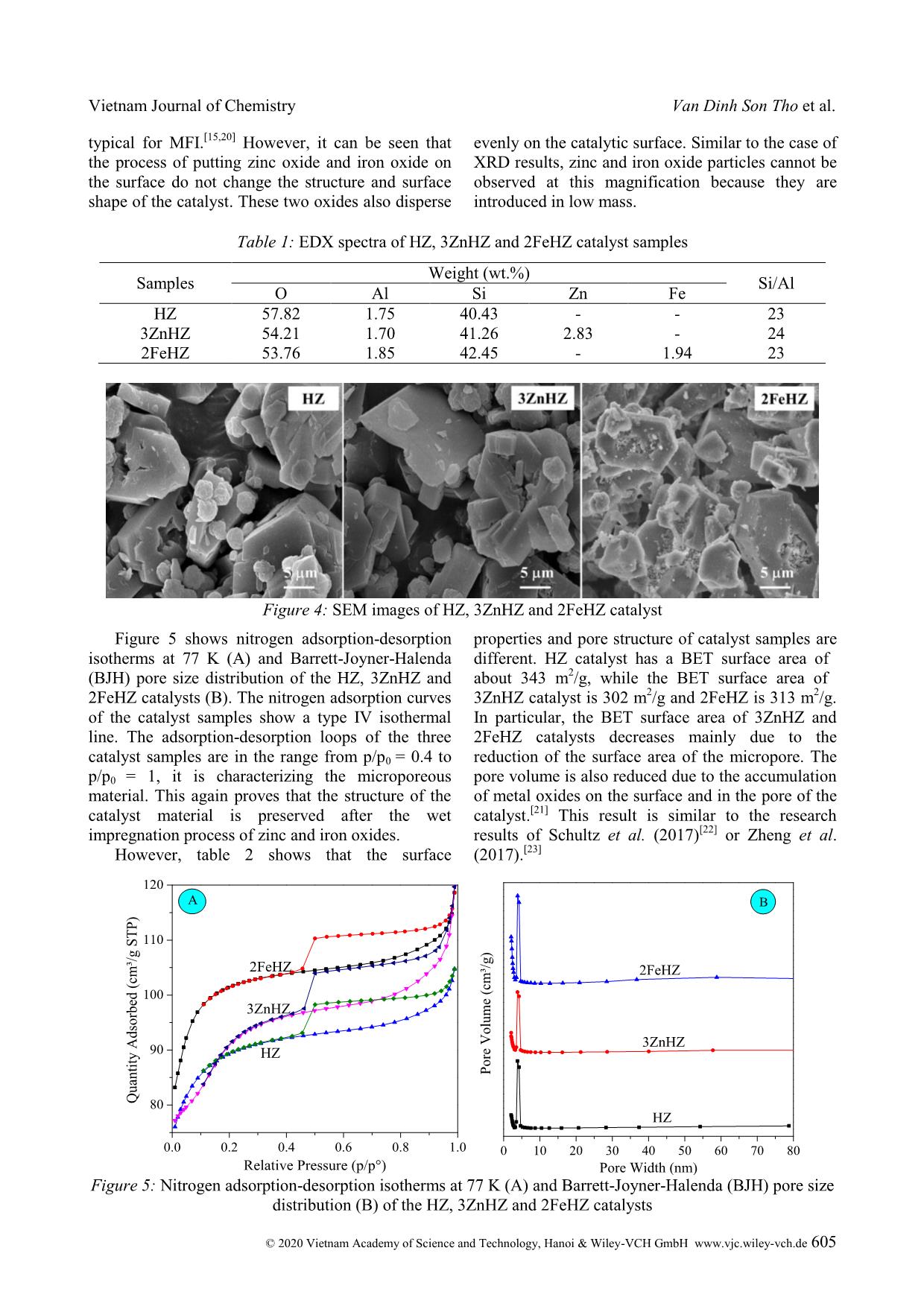
Trang 4
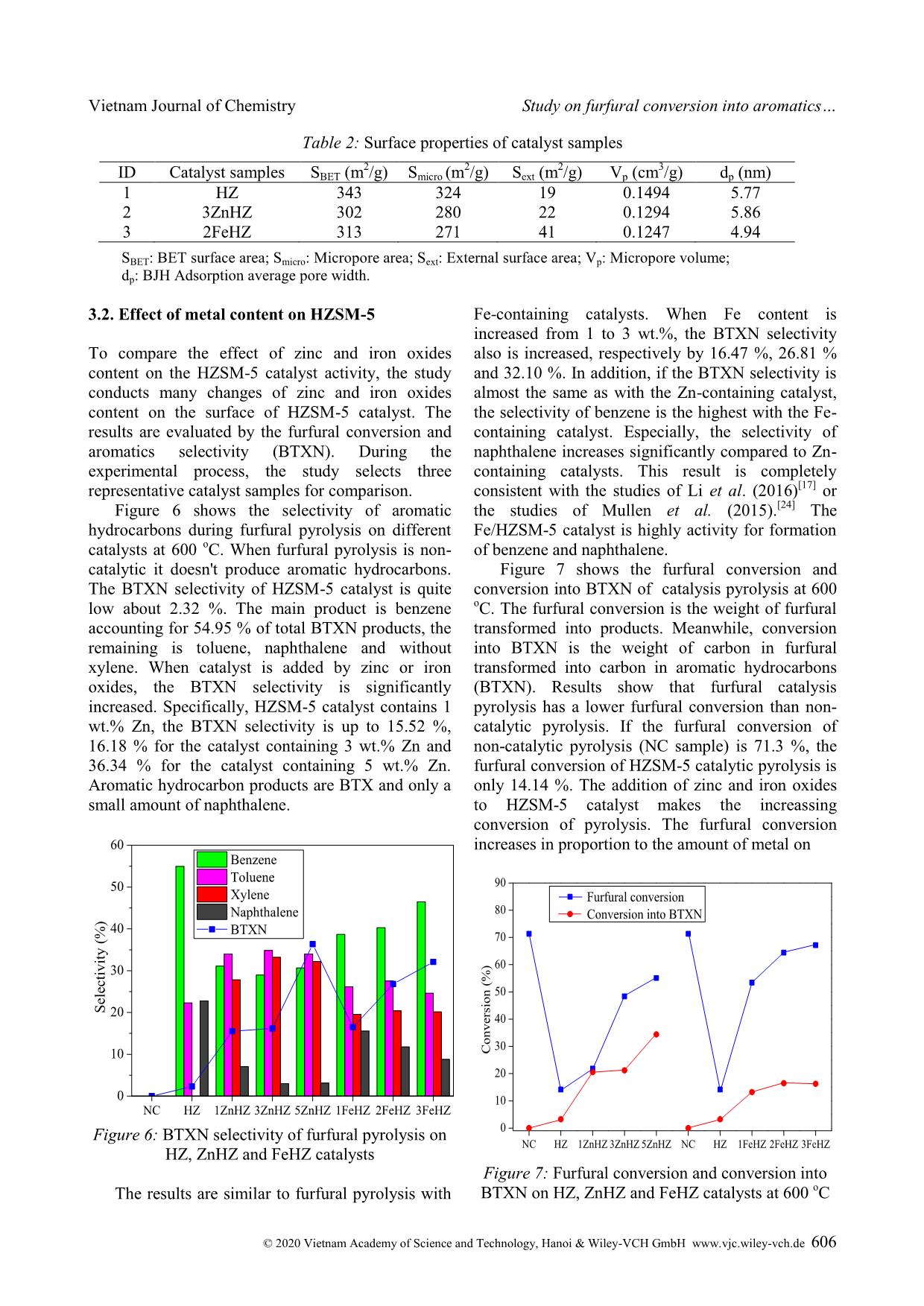
Trang 5
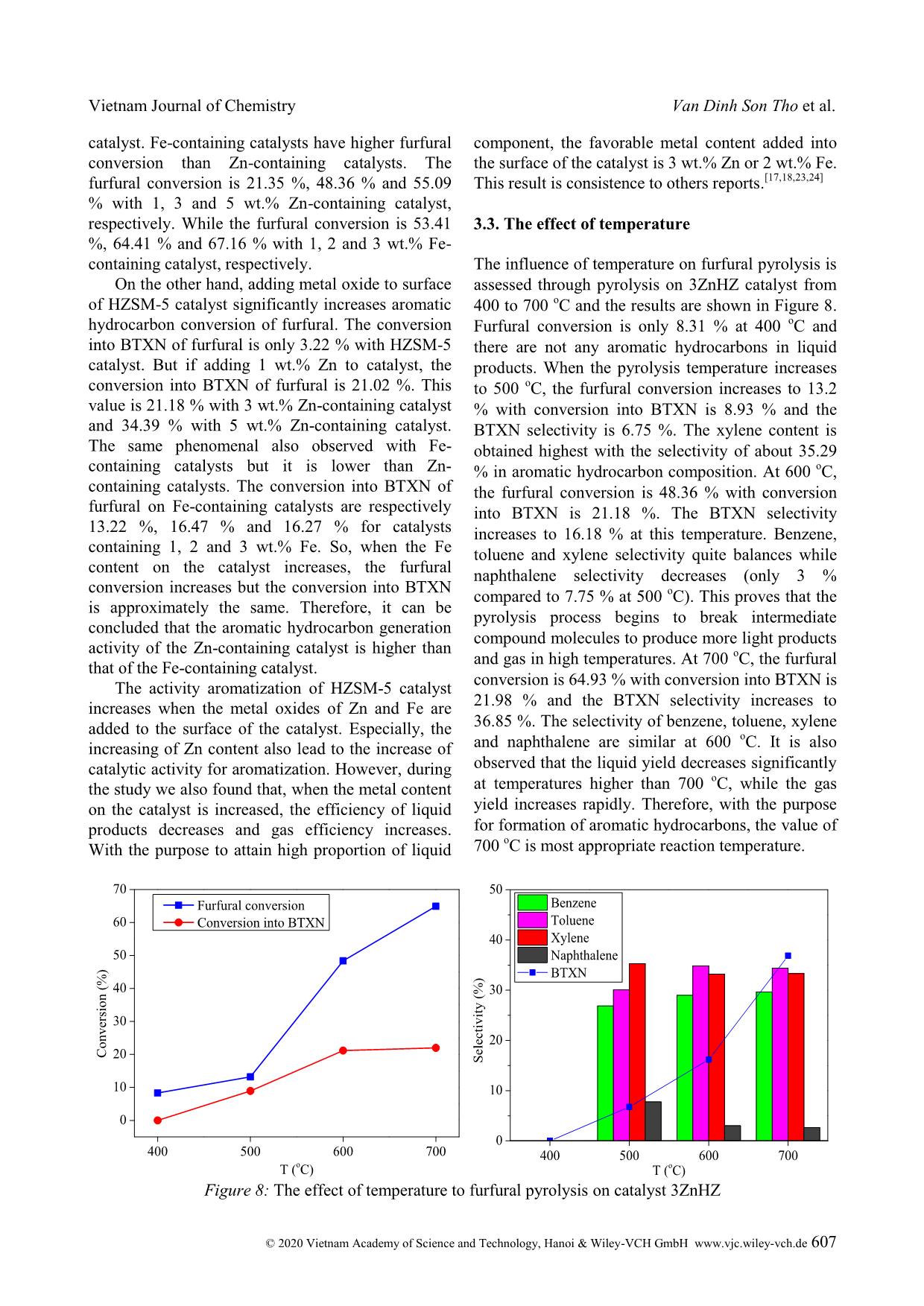
Trang 6
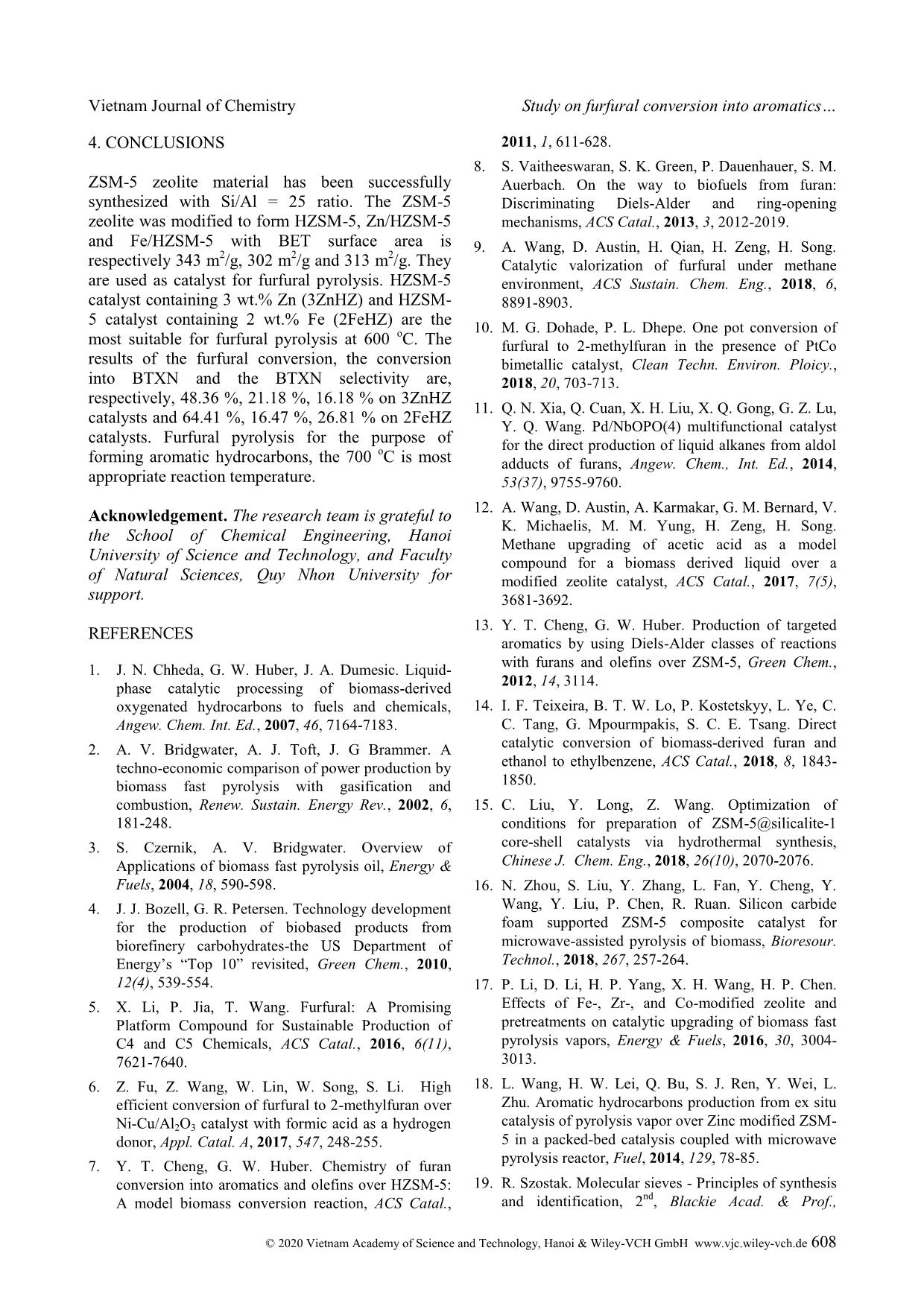
Trang 7
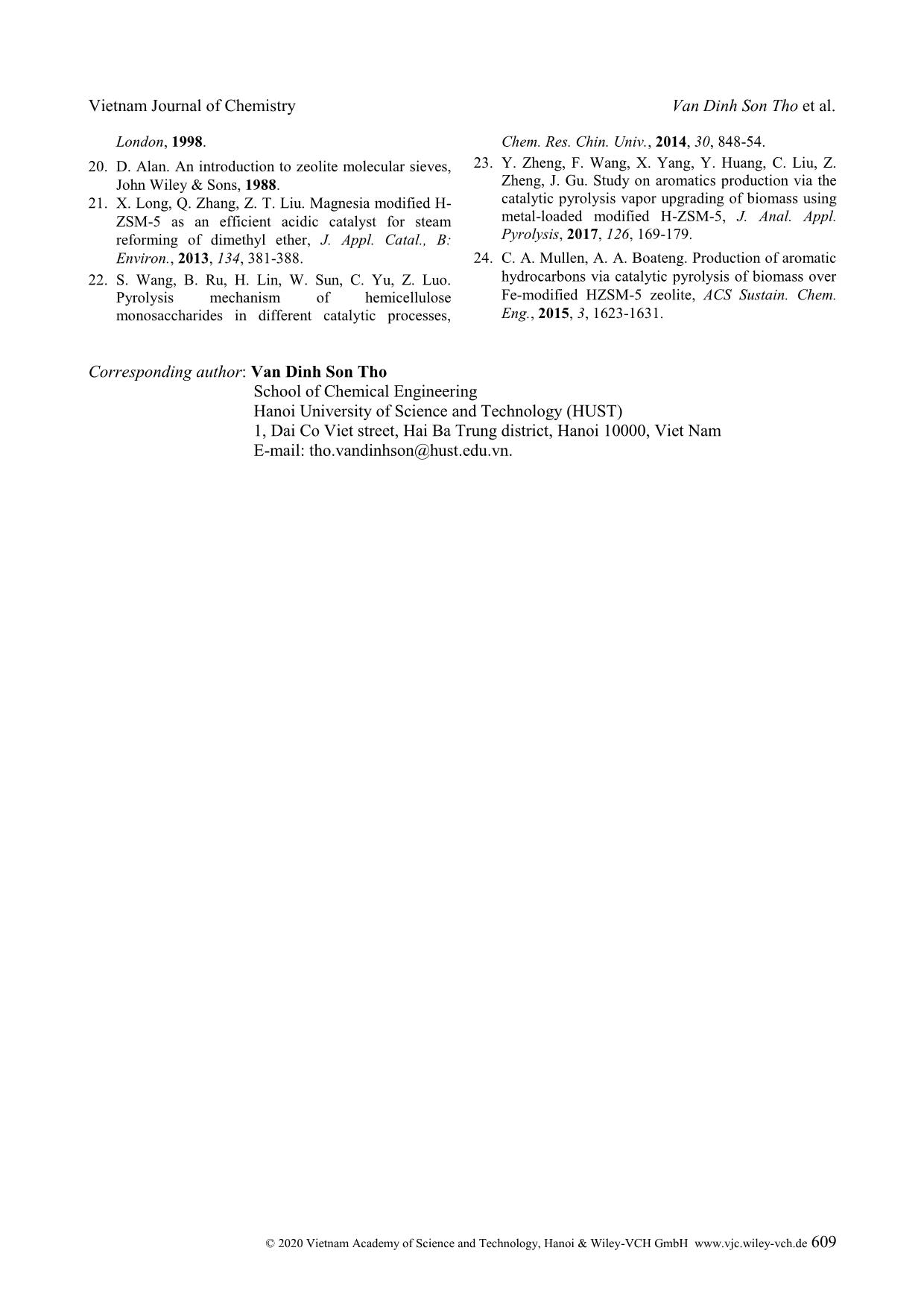
Trang 8
Tóm tắt nội dung tài liệu: Study on furfural conversion into aromatics over Zn/HZSM-5 and Fe/HZSM-5 catalysts
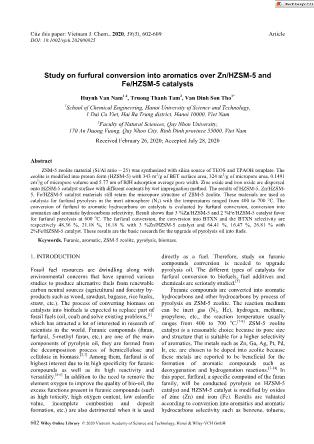
Cite this paper: Vietnam J. Chem., 2020, 58(5), 602-609 Article DOI: 10.1002/vjch.202000025 602 Wiley Online Library © 2020 Vietnam Academy of Science and Technology, Hanoi & Wiley-VCH GmbH Study on furfural conversion into aromatics over Zn/HZSM-5 and Fe/HZSM-5 catalysts Huynh Van Nam 1,2 , Truong Thanh Tam 2 , Van Dinh Son Tho 1* 1 School of Chemical Engineering, Hanoi University of Science and Technology, 1 Dai Co Viet, Hai Ba Trung district, Hanoi 10000, Viet Nam 2 Faculty of Natural Sciences, Quy Nhon University, 170 An Duong Vuong, Quy Nhon City, Binh Dinh province 55000, Viet Nam Received February 26, 2020; Accepted July 28, 2020 Abstract ZSM-5 zeolite material (Si/Al ratio = 25) was synthesized with silica source of TEOS and TPAOH template. The zeolite is modified into proton form (HZSM-5) with 343 m 2 /g of BET surface area, 324 m 2 /g of micropore area, 0.1491 cm 3 /g of micropore volume and 5.77 nm of BJH adsorption average pore width. Zinc oxide and iron oxide are dispersed onto HZSM-5 catalyst surface with different contents by wet impregnation method. The results of HZSM-5, Zn/HZSM- 5, Fe/HZSM-5 catalyst materials still retain the micropore structure of ZSM-5 zeolite. These materials are used as catalysts for furfural pyrolysis in the inert atmosphere (N2) with the temperatures ranged from 400 to 700 °C. The conversion of furfural to aromatic hydrocarbons on catalysts is evaluated by furfural conversion, conversion into aromatics and aromatic hydrocarbons selectivity. Result shows that 3 %Zn/HZSM-5 and 2 %Fe/HZSM-5 catalyst favor for furfural pyrolysis at 600 o C. The furfural conversion, the conversion into BTXN and the BTXN selectivity are respectively 48.36 %, 21.18 %, 16.18 % with 3 %Zn/HZSM-5 catalyst and 64.41 %, 16.47 %, 26.81 % with 2%Fe/HZSM-5 catalyst. These results are the basic research for the upgrade of pyrolysis oil into fuels. Keywords. Furanic, aromatic, ZSM-5 zeolite, pyrolysis, biomass. 1. INTRODUCTION Fossil fuel resources are dwindling along with environmental concerns that have spurred various studies to produce alternative fuels from renewable carbon neutral sources (agricultural and forestry by- products such as wood, sawdust, bagasse, rice husks, straw, etc.). The process of converting biomass on catalysts into biofuels is expected to replace part of fossil fuels (oil, coal) and solve existing problems, [1] which has attracted a lot of interested in research of scientists in the world. Furanic compounds (furan, furfural, 5-methyl furan, etc.) are one of the main components of pyrolysis oil, they are formed from the decomposition process of hemicellulose and cellulose in biomass. [2,3] Among them, furfural is of highest interest due to its high specificity for furanic compounds as well as its high reactivity and versatility. [4-6] In addition to the need to remove the element oxygen to improve the quality of bio-oil, the excess functions present in furanic compounds (such as high toxicity, high oxygen content, low calorific value, incomplete combustion and deposit formation, etc.) are also detrimental when it is used directly as a fuel. Therefore, study on furanic compounds conversion is needed to upgrade pyrolysis oil. The different types of catalysts for furfural conversion to biofuels, fuel additives and chemicals are seriously studied. [5] Furanic compounds are converted into aromatic hydrocarbons and other hydrocarbons by process of pyrolysis on ZSM-5 zeolite. The reaction medium can be inert gas (N2, He), hydrogen, methane, propylene, etc., the reaction temperature usually ranges from 400 to 700 o C. [7-9] ZSM-5 zeolite catalyst is a reasonable choice because its pore size and structure that is suitable for a higher selectivity of aromatics. The metals such as Zn, Ga, Ag, Pt, Pd, Ir, etc. are chosen to be doped into zeolite because these metals are reported to be beneficial for the formation of aromatic compounds such as deoxygenation and hydrogenation reactions. [7-14] In this paper, furfural, a specific compound of the furan family, will be conducted pyrolysis on HZSM-5 catalyst and HZSM-5 catalyst is modified by oxides of zinc (Zn) and iron (Fe). Results are valuated according to conversion into aromatics and aromatic hydrocarbons selectivity such as benzene, toluene, Vietnam Journal of Chemistry Van Dinh Son Tho et al. © 2020 Vietnam Academy of Science and Technology, Hanoi & Wiley-VCH GmbH www.vjc.wiley-vch.de 603 xylene and naphthalene (BTXN). According to Cheng et al. (2011), [7] conversion of furan on HZSM-5 catalyst occurs by the mechanism as shown in figure 1. The furan molecules are adsorbed onto the capillary of HZSM- 5 to form intermediate compounds such as 2,2- methylenebisfuran, benzofuran at temperatures of 400-600 o C. The products are composed of CO, CO2, olefin (C2H4, C3H6) and aromatic compounds (benzene, toluene, xylene and naphtalene). The selectivity of aromatic hydrocarbons and olefins decreases with increasing WHSV, whereas the selectivity of unsaturated hydrocarbon compounds (ethylene, cyclopentadien) increases. The appropriate temperature for the formation of aromatic hydrocarbons is ranges from 450-600 o C. The selectivity of CO, CO2 and olefin increases when the reaction temperature is over 600 o C. In addition, the process also causes Diels-Alder reaction (benzofuran and water are formed by condensation of two furans), decarbonylation (CO and allene are formed from furans), oligomerization (olefins, aromatics and hydrogen are formed from allen), alkylation (forms furan and olefins) and condensation create coke on the catalyst surface, reducing catalytic activity after about 30 minutes of reaction. Figure 1: Mechanism of furan conversion into aromatics on HZSM-5 catalyst [7] F ... ies of catalyst samples ID Catalyst samples SBET (m 2 /g) Smicro (m 2 /g) Sext (m 2 /g) Vp (cm 3 /g) dp (nm) 1 HZ 343 324 19 0.1494 5.77 2 3ZnHZ 302 280 22 0.1294 5.86 3 2FeHZ 313 271 41 0.1247 4.94 SBET: BET surface area; Smicro: Micropore area; Sext: External surface area; Vp: Micropore volume; dp: BJH Adsorption average pore width. 3.2. Effect of metal content on HZSM-5 To compare the effect of zinc and iron oxides content on the HZSM-5 catalyst activity, the study conducts many changes of zinc and iron oxides content on the surface of HZSM-5 catalyst. The results are evaluated by the furfural conversion and aromatics selectivity (BTXN). During the experimental process, the study selects three representative catalyst samples for comparison. Figure 6 shows the selectivity of aromatic hydrocarbons during furfural pyrolysis on different catalysts at 600 o C. When furfural pyrolysis is non- catalytic it doesn't produce aromatic hydrocarbons. The BTXN selectivity of HZSM-5 catalyst is quite low about 2.32 %. The main product is benzene accounting for 54.95 % of total BTXN products, the remaining is toluene, naphthalene and without xylene. When catalyst is added by zinc or iron oxides, the BTXN selectivity is significantly increased. Specifically, HZSM-5 catalyst contains 1 wt.% Zn, the BTXN selectivity is up to 15.52 %, 16.18 % for the catalyst containing 3 wt.% Zn and 36.34 % for the catalyst containing 5 wt.% Zn. Aromatic hydrocarbon products are BTX and only a small amount of naphthalene. NC HZ 1ZnHZ 3ZnHZ 5ZnHZ 1FeHZ 2FeHZ 3FeHZ 0 10 20 30 40 50 60 S e le c ti v it y ( % ) Benzene Toluene Xylene Naphthalene BTXN Figure 6: BTXN selectivity of furfural pyrolysis on HZ, ZnHZ and FeHZ catalysts The results are similar to furfural pyrolysis with Fe-containing catalysts. When Fe content is increased from 1 to 3 wt.%, the BTXN selectivity also is increased, respectively by 16.47 %, 26.81 % and 32.10 %. In addition, if the BTXN selectivity is almost the same as with the Zn-containing catalyst, the selectivity of benzene is the highest with the Fe- containing catalyst. Especially, the selectivity of naphthalene increases significantly compared to Zn- containing catalysts. This result is completely consistent with the studies of Li et al. (2016) [17] or the studies of Mullen et al. (2015). [24] The Fe/HZSM-5 catalyst is highly activity for formation of benzene and naphthalene. Figure 7 shows the furfural conversion and conversion into BTXN of catalysis pyrolysis at 600 o C. The furfural conversion is the weight of furfural transformed into products. Meanwhile, conversion into BTXN is the weight of carbon in furfural transformed into carbon in aromatic hydrocarbons (BTXN). Results show that furfural catalysis pyrolysis has a lower furfural conversion than non- catalytic pyrolysis. If the furfural conversion of non-catalytic pyrolysis (NC sample) is 71.3 %, the furfural conversion of HZSM-5 catalytic pyrolysis is only 14.14 %. The addition of zinc and iron oxides to HZSM-5 catalyst makes the increassing conversion of pyrolysis. The furfural conversion increases in proportion to the amount of metal on NC HZ 1ZnHZ 3ZnHZ 5ZnHZ NC HZ 1FeHZ 2FeHZ 3FeHZ 0 10 20 30 40 50 60 70 80 90 C o n v e rs io n ( % ) Furfural conversion Conversion into BTXN Figure 7: Furfural conversion and conversion into BTXN on HZ, ZnHZ and FeHZ catalysts at 600 o C Vietnam Journal of Chemistry Van Dinh Son Tho et al. © 2020 Vietnam Academy of Science and Technology, Hanoi & Wiley-VCH GmbH www.vjc.wiley-vch.de 607 catalyst. Fe-containing catalysts have higher furfural conversion than Zn-containing catalysts. The furfural conversion is 21.35 %, 48.36 % and 55.09 % with 1, 3 and 5 wt.% Zn-containing catalyst, respectively. While the furfural conversion is 53.41 %, 64.41 % and 67.16 % with 1, 2 and 3 wt.% Fe- containing catalyst, respectively. On the other hand, adding metal oxide to surface of HZSM-5 catalyst significantly increases aromatic hydrocarbon conversion of furfural. The conversion into BTXN of furfural is only 3.22 % with HZSM-5 catalyst. But if adding 1 wt.% Zn to catalyst, the conversion into BTXN of furfural is 21.02 %. This value is 21.18 % with 3 wt.% Zn-containing catalyst and 34.39 % with 5 wt.% Zn-containing catalyst. The same phenomenal also observed with Fe- containing catalysts but it is lower than Zn- containing catalysts. The conversion into BTXN of furfural on Fe-containing catalysts are respectively 13.22 %, 16.47 % and 16.27 % for catalysts containing 1, 2 and 3 wt.% Fe. So, when the Fe content on the catalyst increases, the furfural conversion increases but the conversion into BTXN is approximately the same. Therefore, it can be concluded that the aromatic hydrocarbon generation activity of the Zn-containing catalyst is higher than that of the Fe-containing catalyst. The activity aromatization of HZSM-5 catalyst increases when the metal oxides of Zn and Fe are added to the surface of the catalyst. Especially, the increasing of Zn content also lead to the increase of catalytic activity for aromatization. However, during the study we also found that, when the metal content on the catalyst is increased, the efficiency of liquid products decreases and gas efficiency increases. With the purpose to attain high proportion of liquid component, the favorable metal content added into the surface of the catalyst is 3 wt.% Zn or 2 wt.% Fe. This result is consistence to others reports. [17,18,23,24] 3.3. The effect of temperature The influence of temperature on furfural pyrolysis is assessed through pyrolysis on 3ZnHZ catalyst from 400 to 700 o C and the results are shown in Figure 8. Furfural conversion is only 8.31 % at 400 o C and there are not any aromatic hydrocarbons in liquid products. When the pyrolysis temperature increases to 500 o C, the furfural conversion increases to 13.2 % with conversion into BTXN is 8.93 % and the BTXN selectivity is 6.75 %. The xylene content is obtained highest with the selectivity of about 35.29 % in aromatic hydrocarbon composition. At 600 o C, the furfural conversion is 48.36 % with conversion into BTXN is 21.18 %. The BTXN selectivity increases to 16.18 % at this temperature. Benzene, toluene and xylene selectivity quite balances while naphthalene selectivity decreases (only 3 % compared to 7.75 % at 500 o C). This proves that the pyrolysis process begins to break intermediate compound molecules to produce more light products and gas in high temperatures. At 700 o C, the furfural conversion is 64.93 % with conversion into BTXN is 21.98 % and the BTXN selectivity increases to 36.85 %. The selectivity of benzene, toluene, xylene and naphthalene are similar at 600 o C. It is also observed that the liquid yield decreases significantly at temperatures higher than 700 o C, while the gas yield increases rapidly. Therefore, with the purpose for formation of aromatic hydrocarbons, the value of 700 o C is most appropriate reaction temperature. 400 500 600 700 0 10 20 30 40 50 60 70 C o n v e rs io n ( % ) T ( o C) Furfural conversion Conversion into BTXN 400 500 600 700 0 10 20 30 40 50 S e le c ti v it y ( % ) T ( o C) Benzene Toluene Xylene Naphthalene BTXN Figure 8: The effect of temperature to furfural pyrolysis on catalyst 3ZnHZ Vietnam Journal of Chemistry Study on furfural conversion into aromatics © 2020 Vietnam Academy of Science and Technology, Hanoi & Wiley-VCH GmbH www.vjc.wiley-vch.de 608 4. CONCLUSIONS ZSM-5 zeolite material has been successfully synthesized with Si/Al = 25 ratio. The ZSM-5 zeolite was modified to form HZSM-5, Zn/HZSM-5 and Fe/HZSM-5 with BET surface area is respectively 343 m 2 /g, 302 m 2 /g and 313 m 2 /g. They are used as catalyst for furfural pyrolysis. HZSM-5 catalyst containing 3 wt.% Zn (3ZnHZ) and HZSM- 5 catalyst containing 2 wt.% Fe (2FeHZ) are the most suitable for furfural pyrolysis at 600 o C. The results of the furfural conversion, the conversion into BTXN and the BTXN selectivity are, respectively, 48.36 %, 21.18 %, 16.18 % on 3ZnHZ catalysts and 64.41 %, 16.47 %, 26.81 % on 2FeHZ catalysts. Furfural pyrolysis for the purpose of forming aromatic hydrocarbons, the 700 o C is most appropriate reaction temperature. Acknowledgement. The research team is grateful to the School of Chemical Engineering, Hanoi University of Science and Technology, and Faculty of Natural Sciences, Quy Nhon University for support. REFERENCES 1. J. N. Chheda, G. W. Huber, J. A. Dumesic. Liquid- phase catalytic processing of biomass-derived oxygenated hydrocarbons to fuels and chemicals, Angew. Chem. Int. Ed., 2007, 46, 7164-7183. 2. A. V. Bridgwater, A. J. Toft, J. G Brammer. A techno-economic comparison of power production by biomass fast pyrolysis with gasification and combustion, Renew. Sustain. Energy Rev., 2002, 6, 181-248. 3. S. Czernik, A. V. Bridgwater. Overview of Applications of biomass fast pyrolysis oil, Energy & Fuels, 2004, 18, 590-598. 4. J. J. Bozell, G. R. Petersen. Technology development for the production of biobased products from biorefinery carbohydrates-the US Department of Energy’s “Top ” revisited, Green Chem., 2010, 12(4), 539-554. 5. X. Li, P. Jia, T. Wang. Furfural: A Promising Platform Compound for Sustainable Production of C4 and C5 Chemicals, ACS Catal., 2016, 6(11), 7621-7640. 6. Z. Fu, Z. Wang, W. Lin, W. Song, S. Li. High efficient conversion of furfural to 2-methylfuran over Ni-Cu/Al2O3 catalyst with formic acid as a hydrogen donor, Appl. Catal. A, 2017, 547, 248-255. 7. Y. T. Cheng, G. W. Huber. Chemistry of furan conversion into aromatics and olefins over HZSM-5: A model biomass conversion reaction, ACS Catal., 2011, 1, 611-628. 8. S. Vaitheeswaran, S. K. Green, P. Dauenhauer, S. M. Auerbach. On the way to biofuels from furan: Discriminating Diels-Alder and ring-opening mechanisms, ACS Catal., 2013, 3, 2012-2019. 9. A. Wang, D. Austin, H. Qian, H. Zeng, H. Song. Catalytic valorization of furfural under methane environment, ACS Sustain. Chem. Eng., 2018, 6, 8891-8903. 10. M. G. Dohade, P. L. Dhepe. One pot conversion of furfural to 2-methylfuran in the presence of PtCo bimetallic catalyst, Clean Techn. Environ. Ploicy., 2018, 20, 703-713. 11. Q. N. Xia, Q. Cuan, X. H. Liu, X. Q. Gong, G. Z. Lu, Y. Q. Wang. Pd/NbOPO(4) multifunctional catalyst for the direct production of liquid alkanes from aldol adducts of furans, Angew. Chem., Int. Ed., 2014, 53(37), 9755-9760. 12. A. Wang, D. Austin, A. Karmakar, G. M. Bernard, V. K. Michaelis, M. M. Yung, H. Zeng, H. Song. Methane upgrading of acetic acid as a model compound for a biomass derived liquid over a modified zeolite catalyst, ACS Catal., 2017, 7(5), 3681-3692. 13. Y. T. Cheng, G. W. Huber. Production of targeted aromatics by using Diels-Alder classes of reactions with furans and olefins over ZSM-5, Green Chem., 2012, 14, 3114. 14. I. F. Teixeira, B. T. W. Lo, P. Kostetskyy, L. Ye, C. C. Tang, G. Mpourmpakis, S. C. E. Tsang. Direct catalytic conversion of biomass-derived furan and ethanol to ethylbenzene, ACS Catal., 2018, 8, 1843- 1850. 15. C. Liu, Y. Long, Z. Wang. Optimization of conditions for preparation of ZSM-5@silicalite-1 core-shell catalysts via hydrothermal synthesis, Chinese J. Chem. Eng., 2018, 26(10), 2070-2076. 16. N. Zhou, S. Liu, Y. Zhang, L. Fan, Y. Cheng, Y. Wang, Y. Liu, P. Chen, R. Ruan. Silicon carbide foam supported ZSM-5 composite catalyst for microwave-assisted pyrolysis of biomass, Bioresour. Technol., 2018, 267, 257-264. 17. P. Li, D. Li, H. P. Yang, X. H. Wang, H. P. Chen. Effects of Fe-, Zr-, and Co-modified zeolite and pretreatments on catalytic upgrading of biomass fast pyrolysis vapors, Energy & Fuels, 2016, 30, 3004- 3013. 18. L. Wang, H. W. Lei, Q. Bu, S. J. Ren, Y. Wei, L. Zhu. Aromatic hydrocarbons production from ex situ catalysis of pyrolysis vapor over Zinc modified ZSM- 5 in a packed-bed catalysis coupled with microwave pyrolysis reactor, Fuel, 2014, 129, 78-85. 19. R. Szostak. Molecular sieves - Principles of synthesis and identification, 2 nd , Blackie Acad. & Prof., Vietnam Journal of Chemistry Van Dinh Son Tho et al. © 2020 Vietnam Academy of Science and Technology, Hanoi & Wiley-VCH GmbH www.vjc.wiley-vch.de 609 London, 1998. 20. D. Alan. An introduction to zeolite molecular sieves, John Wiley & Sons, 1988. 21. X. Long, Q. Zhang, Z. T. Liu. Magnesia modified H- ZSM-5 as an efficient acidic catalyst for steam reforming of dimethyl ether, J. Appl. Catal., B: Environ., 2013, 134, 381-388. 22. S. Wang, B. Ru, H. Lin, W. Sun, C. Yu, Z. Luo. Pyrolysis mechanism of hemicellulose monosaccharides in different catalytic processes, Chem. Res. Chin. Univ., 2014, 30, 848-54. 23. Y. Zheng, F. Wang, X. Yang, Y. Huang, C. Liu, Z. Zheng, J. Gu. Study on aromatics production via the catalytic pyrolysis vapor upgrading of biomass using metal-loaded modified H-ZSM-5, J. Anal. Appl. Pyrolysis, 2017, 126, 169-179. 24. C. A. Mullen, A. A. Boateng. Production of aromatic hydrocarbons via catalytic pyrolysis of biomass over Fe-modified HZSM-5 zeolite, ACS Sustain. Chem. Eng., 2015, 3, 1623-1631. Corresponding author: Van Dinh Son Tho School of Chemical Engineering Hanoi University of Science and Technology (HUST) 1, Dai Co Viet street, Hai Ba Trung district, Hanoi 10000, Viet Nam E-mail: tho.vandinhson@hust.edu.vn.
File đính kèm:
 study_on_furfural_conversion_into_aromatics_over_znhzsm_5_an.pdf
study_on_furfural_conversion_into_aromatics_over_znhzsm_5_an.pdf

